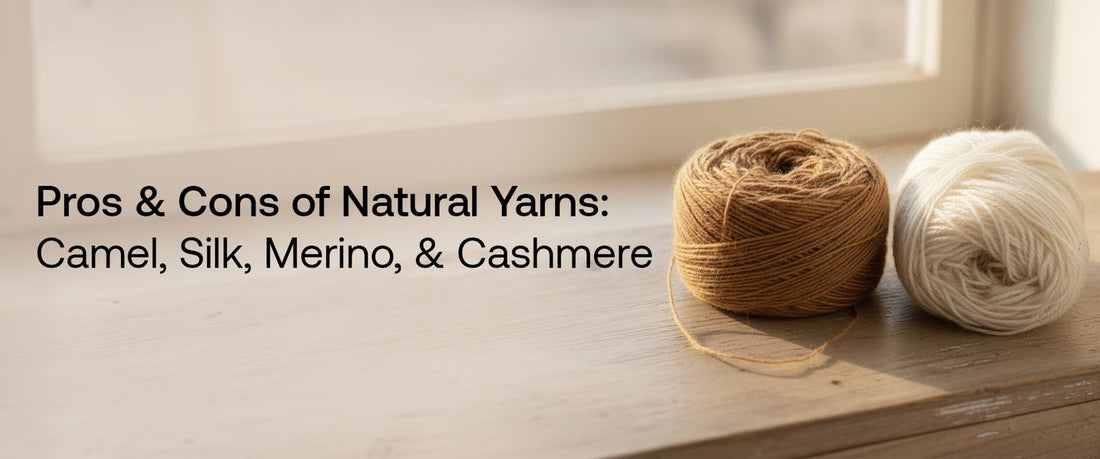
Pros & Cons of Natural Yarns: Camel, Silk, Merino & Cashmere
Natural fibers have always held a special place in luxury and performance clothing. They offer softness, warmth, breathability, and timeless appeal that synthetic materials cannot replicate. Each yarn has its own character, shaped by nature and refined by craftsmanship. At Brrotank, these fibers are chosen for their authenticity and the comfort they provide.
Here’s a closer look at the unique qualities, benefits, and considerations of five exceptional natural yarns: Bactrian camel, Mulberry silk, ZQ fine Merino, Brushtail Possum Down, and cashmere.
1. Bactrian Camel Wool
Pros
Bactrian camel wool is renowned for its warmth and strength. The fibers come from the soft undercoat of camels native to Central Asia, where they endure harsh climates. This wool naturally regulates temperature, keeping warmth in without trapping excess heat.
- Excellent insulation suitable for cold climates
- Naturally elastic and durable
- Hypoallergenic and lanolin-free, making it gentle on skin
- Collected during natural shedding seasons, ensuring ethical sourcing
- Resistant to wrinkles and maintains structure well
Cons
While prized for performance, Bactrian camel wool is relatively rare.
- Limited supply increases production cost
- Natural color options are usually earthy tones
- May feel slightly coarse without fine processing
2. Mulberry Silk
Pros
Mulberry silk is known for its luminous sheen and luxurious feel. Produced by silkworms fed exclusively on mulberry leaves, it is among the purest and strongest forms of natural silk. The fibers are long, smooth, and uniform, giving them a distinct elegance.
- Extremely soft and lightweight
- Naturally temperature-regulating for year-round comfort
- Hypoallergenic and breathable
- Strong tensile strength for durability
- Beautiful drape that enhances any garment
Cons
Despite its beauty, Mulberry silk needs careful handling.
- Prone to damage from sunlight and harsh detergents
- Requires gentle washing or dry cleaning
- More costly due to labor-intensive production
- It can lose its sheen over time if not properly stored
3. ZQ Fine Merino Wool
Pros
ZQ fine Merino wool represents a commitment to ethical and sustainable fiber production. It comes from Merino sheep raised under the ZQ certification, which ensures animal welfare, environmental care, and traceability.
- Exceptionally soft and non-itchy
- Breathable and moisture-wicking
- Naturally odor-resistant, ideal for everyday and active wear
- Biodegradable and renewable
- Retains shape and elasticity through repeated use
Cons
Even with its performance benefits, ZQ fine Merino requires attention in care.
- Needs gentle washing and air drying
- Fine fibers can pill with heavy wear
- Generally, more expensive due to responsible sourcing
4. Brushtail Possum Down
Pros
Brushtail Possum Down is one of the softest and warmest natural fibers in the world. It is ethically sourced from New Zealand, where the possum population is carefully managed to protect native forests. The hollow core of the fiber traps heat efficiently, providing exceptional insulation.
- Incredibly lightweight with superior warmth
- Natural hollow fibers enhance thermal retention
- Luxuriously soft texture similar to cashmere
- Often blended with Merino for added durability
- Eco-friendly sourcing contributes to environmental balance
Cons
Brushtail Possum Down is rare and often blended with other fibers to enhance structure.
- Pure fiber can be delicate if not reinforced
- Availability may vary outside New Zealand
- Higher price due to ethical collection and limited supply
5. Cashmere
Pros
Cashmere is widely considered the pinnacle of natural luxury. It is sourced from the fine undercoat of cashmere goats, primarily found in Mongolia, China, and parts of India. The fibers are incredibly soft, warm, and lightweight, offering unparalleled comfort.
- Exceptional softness against the skin
- Provides warmth without heaviness
- Naturally breathable and gentle for sensitive skin
- Drapes beautifully and resists wrinkles
- Ages gracefully with proper care
Cons
True cashmere is rare and valuable, requiring careful maintenance.
- High cost due to limited availability and manual production
- Delicate and prone to pilling
- Requires hand washing or dry cleaning
- Sensitive to friction and rough surfaces
Also, Read Why We Use Inner Layers of Mongolian Cashmere Wool and Bactrian Camel?
Conclusion
Each of these natural yarns carries its own charm and purpose. From the strength of Bactrian camel wool to the refinement of Mulberry silk, the resilience of ZQ fine Merino, the warmth of Brushtail Possum Down, and the elegance of cashmere, each fiber is nature’s way of blending beauty with function.
At Brrotank, these materials are chosen with care to create garments that feel as genuine as they look. Every layer is designed to celebrate comfort, craftsmanship, and conscious living.



